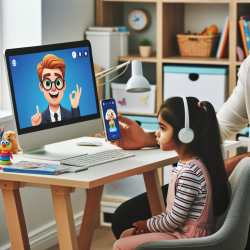As a speech-language pathologist, the importance of making data-driven decisions cannot be overstated. When it comes to improving outcomes for children, leveraging research and empirical evidence is paramount. In this blog, we delve into findings from a notable study published in the Canadian Journal of Speech-Language Pathology and Audiology (CJSLPA) / Revue canadienne d'orthophonie et d'audiologie (RCOA) and explore how these insights can be implemented to enhance the effectiveness of online therapy services provided by TinyEYE.
The study titled "An Evaluation of the Responsiveness of the Pre-Kindergarten ASHA NOMS" by Nancy Thomas-Stonell et al. investigates the responsiveness of the American Speech-Language-Hearing Association's Pre-Kindergarten National Outcomes Measurement System (Pre-K NOMS). This research is particularly relevant for practitioners aiming to quantify and improve functional communication changes in young children receiving speech and language interventions.
Key Findings
- The study evaluated 213 children aged 3 to 5 years, comparing changes in Pre-K NOMS scores with ratings from both parents and treating clinicians.
- It was found that while parents and clinicians agreed that 96% of children made real-life communication improvements, the Pre-K NOMS identified only 68% of these cases.
- The Pre-K NOMS missed detecting 29% of children who showed observable real-life changes, highlighting a potential gap in the tool's sensitivity.
Implications for Practice
The findings underscore the need for practitioners to use multiple measures when evaluating treatment outcomes. Relying solely on the Pre-K NOMS could result in underestimating the progress made by children in therapy. Here are some actionable steps to enhance practice based on this research:
1. Use Multiple Assessment Tools
Integrate various assessment tools alongside the Pre-K NOMS to capture a comprehensive picture of a child's progress. This could include parent and clinician ratings, observational checklists, and other standardized tests.
2. Focus on Functional Outcomes
Emphasize real-life communication changes that impact a child's daily interactions. Engage parents and caregivers in the assessment process to gather insights on how therapy is translating into everyday improvements.
3. Continuous Monitoring and Adjustment
Regularly monitor the child's progress using a combination of tools and adjust therapy goals and methods accordingly. This ensures that interventions remain effective and responsive to the child's evolving needs.
Encouraging Further Research
While the study provides valuable insights, it also highlights the need for further research to refine outcome measurement tools. Practitioners are encouraged to participate in research initiatives and contribute to the development of more sensitive and comprehensive assessment methods.
By integrating these research findings into practice, speech-language pathologists can enhance the quality of online therapy services and achieve better outcomes for children. To read the original research paper, please follow this link: Canadian Journal of Speech-Language Pathology and Audiology (CJSLPA) / Revue canadienne d'orthophonie et d'audiologie (RCOA).










